

Tulane University
1971 Green Wave
(Authentic Reproduction)
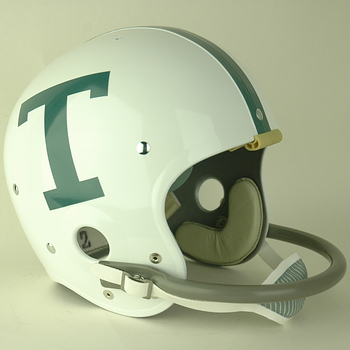 |
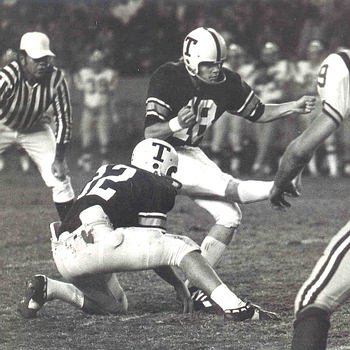 |
Always known as a bastion of academic excellence, Tulane University did in fact play very good football quite some time ago. With its inaugural mission as a medical college and expansion as a comprehensive university community, Tulane has had a position of prestige dating to the mid-1800s. After the founding of its football program in 1893, they were fortunate to engage the services of two of the outstanding football minds of the Twentieth Century as they built a national reputation. Both College Football Hall Of Fame inductees, Clark Shaughnessy, “The Father Of The T-Formation” and Bernie Bierman who later won acclaim and five national championships as the head coach of the University Of Minnesota, planted the Green Wave of Tulane firmly on the football map between the pre-World War I and pre-World War II era. Tulane defeated Temple University in the 1935 inaugural Sugar Bowl match-up and enjoyed a reputation of excellence in the classroom and on the gridiron.
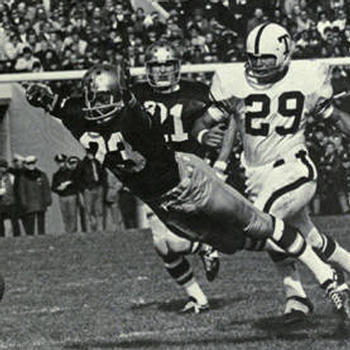 |
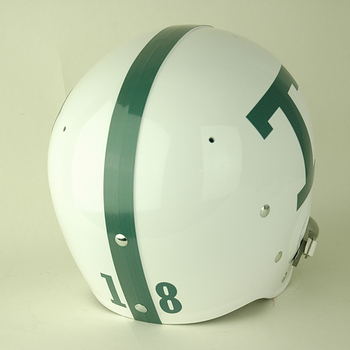 |
The post-World War II period, despite featuring stars like Max McGee, Richie Petitbon, and Tommy Mason, was not as kind and the program amassed but thirty-seven victories between 1952 and 1965 with the 1962 contingent getting washed out at 0-10. The proud Green Wave had been a part of the Southeastern Conference since its inception in 1933 but in the 1950s, was part of a group of private, academically oriented southern schools that considered the formation of a Magnolia Conference. Unable to keep up athletically with the large state supported universities of the vaunted SEC, and with much higher academic standards, Tulane was all in for a conglomeration of Vanderbilt, Duke, SMU, and Rice with the intent to seek play with regional schools and the established northern Ivy League Conference. This never came to pass and the university realized it needed to leave the SEC, beginning Independent status prior to the 1966 season. The program began its foray as an Independent with new head football coach Jim Pittman, a former Mississippi State stand-out player and assistant coach who remained on Darrell Royal’s staffs at MSU, Washington, and Texas during the Longhorns’ superb years of the early 1960s. A great choice for Tulane, he utilized a newly instituted Physical Education major, a bit of admissions leniency, and excellent coaching and took them back to respectability. By 1970, the locally anointed “Year Of The Green,” he achieved an 8-4 mark and Liberty Bowl victory over Colorado, the Greenies first bowl appearance since 1939. Not surprisingly, he was courted by major schools, signed with Texas Christian University for the ’71 season, but tragically suffered a fatal heart attack on the sideline during the October 31st game against Baylor. Tulane meanwhile called upon Bennie Ellender, its own former starting quarterback to maintain the level of improvement the squad had attained under Pittman. Ellender had been recruited as a multi-sport star by Tulane out of Sulphur, Louisiana and made his mark as a tailback and wingback on the 1943 and ’44 teams. He entered the United States Navy, serving part of his time on the submarine force, and returned to Tulane after the War, playing quarterback and safety in 1947, and starting at both positions in ’48.
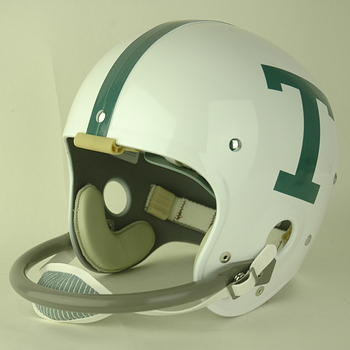 |
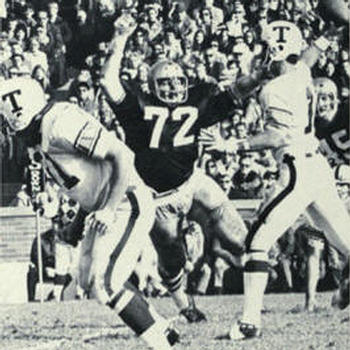 |
As a successful high school coach in Westlake, Louisiana and at his Sulphur High School alma mater, he entered the college assistant ranks at Tulane and then Arkansas State. Named the head coach at ASU in 1963, his eight year tenure brought the Small College National Championship in 1970 with an 11-0 record, two Pecan Bowl titles, six national rankings, three Southland Conference Coach Of The Year Awards, and the College Division Coach Of The Year in 1970. A strong disciplinarian that was highly regarded, respected, and beloved by his players and assistants for his honesty and fairness, Ellender was a popular choice to take Tulane to stability at the much higher level of play that Pittman had established. He made a number of changes for 1971, installing a 5-2 Rover Defense in place of Pittman’s 4-4 and as many new coaches do, also altered the uniform with a new helmet design. For years Tulane had worn a white helmet shell with player identification numerals on both sides of the shell. For the 1970 season, Pittman had located the numerals beneath a “T” that was within a football shaped oval but many felt that the new decal was poorly visualized from the Tulane Stadium stands. Ellender introduced a one-inch green center stripe with a “Tulane representative T” on each side of their standard white shell which provided an immediately recognizable appearance. The green player identification numerals were moved to the rear of the shell, flanking the center stripe.
With fourteen starters returning
from the 8-4 ’70 squad, it was hoped that the momentum of the 17-3 Liberty
Bowl victory over Colorado that concluded the 1970 season would carry
forward. With fan interest rabid for the “Year Of The Green-Plus One,” a
blocked punt by defensive end Mike Truax who later played with Birmingham of
the World Football League was needed to pull out a victory over Texas Tech
in the opener which should have indicated that the team perhaps would not
live up to its lofty expectations. Despite the return of nationally ranked
punt returner and left cornerback “Bullet” Joe Bullard and the defensive
backfield of “Bullard’s Bandits” who had intercepted the bulk of the team
record twenty-eight in ’70, the Green Wave then lost three in a row before
defeating North Carolina and Pittsburgh. Renewed hope was dashed by five
consecutive defeats despite terrific defensive play from leading tackler
linebacker Mike “Moon” Mullen who compiled twenty-four of his stops against
Notre Dame, the record setting receiving of wide out Steve Barrios, and the
819 rushing yards contributed by tailback Ricky Hebert. Barrios was later
drafted by the Saints, Bullard by the Oilers, and Mullen by the Dolphins.
Leaving the 3-8 record of 1971
behind and its helmet as a one season model, Ellender maintained the green
center stripe and the Tulane “T” on the ’72 version of the helmet but
tweaked the “T” by turning the edges of its feet up on each side. The change
certainly did not hurt as the Wave returned to a 6-5 winning slate and then
completed the ’73 season, under the direction of quarterback Steve Foley who
later became an All Pro defensive back as a Denver Bronco, with a terrific
9-3 mark that concluded the regular season with a 14-0 win against hated
rival LSU. The joy of that victory, the first over the Bayou Bengals since
1948, was not dampened by a blowout loss to Houston in the Bluebonnet Bowl
Game four weeks later and Ellender was rewarded with a ten-year contract!
Unfortunately, 1973 proved to be his high water mark at Tulane as 1974
brought a 5-6 record and ’75 saw that dip to 4-7. His ten-year contract was
terminated despite having a 27-29 record that left him as one of the
school’s most successful head coaches. Ellender entered the real estate and
oil field services industries where he also had a large measure of success
and he kept a hand in football by helping to coordinate the East team in the
Annual East West Shrine Game. As did his Arkansas State players and those
at Tulane who followed his ’71 squad, Ellender was accorded with much
respect. Arkansas State Director of Major Gifts Bill Templeton stated that
“Everyone who ever played or coached for Bennie Ellender loved him” and this
was a frequently repeated quote. Although the 1971 team, with its simple
but distinctive helmet design, proved a bit disappointing, it laid the
foundation for the successful team of 1973 and was part of one of the most
rewarding periods for Tulane football.